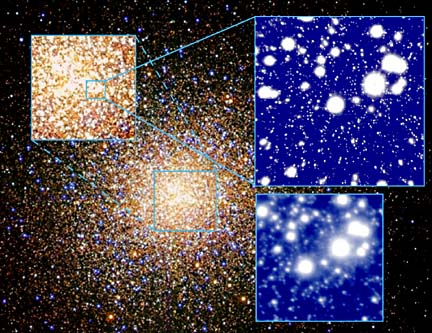
COURTESY PHOTO
Remarkable details in the core of the globular cluster M-13 are revealed in a new image obtained with the Gemini Observatory's new Altair adaptive optics system at the Frederick C. Gillett Telescope (Gemini North) on Hawaii's Mauna Kea. The razor-sharp Gemini image is shown in the upper right of the above sequence, which also includes a wide-field view of the cluster (and enlargement of the core) as imaged by the Canada-France-Hawaii Telescope, also on Mauna Kea.
Astronomy photos are
astonishingly clearA new optical system used on a telescope
atop Mauna Kea is a significant advance
HILO >> Gemini Observatory officials displayed images yesterday that they said showed a significant advance in the clarity of pictures produced by the giant telescope atop Mauna Kea.
The images offered in demonstration were of the Great Hercules Cluster, an enormous mass of stars orbiting around the center of the Milky Way, visible to the naked eye in summer skies as a blob in the constellation Hercules.
A powerful telescope like the 3.6-meter Canada-France-Hawaii Telescope on Mauna Kea does a fairly good job of distinguishing individuals points of light in the cluster, estimated to contain several hundred thousand stars.
But a Canadian-built instrument on the 8-meter Altair makes them still clearer, a Gemini image showed.
And work is under way to increase the clarity, the observatory said.
According to the observatory, the Altair senses turbulence in the air above the telescope, then smoothes out the resulting turbulence in star light. A flexible, palm-size mirror is made to wobble up to 1,000 times per second to smooth the light. Complex software controls 20 motors, said software engineer Jennifer Dunn.
The process, called "adaptive optics," has been in use for a few years, but existing systems result in greatest clarity in only a limited area of the image, said Gemini adaptive-optics expert Francois Rigaut.
The Canadian instrument gives the same degree of clarity across twice the width of view, he said.
Gemini officials used Earth-based examples to illustrate the clarity.
"The resolution obtained in these images is approximately equivalent to seeing the separation between an automobile's headlights on the Golden Gate Bridge in San Francisco while standing 3,850 kilometers (2,392 miles) away in Hawaii," Rigaut said.
Without the Altair, he said, the two headlights would blend into one.
Gemini Director Matt Mountain likened the clarity to seeing a grain of sand from a mile away.
At a meeting of the Canadian Astronomical Society in Waterloo, Ontario, yesterday, the Altair system was described as capturing three times more detail than the Hubble Space Telescope. Thus, it will be good for seeing faint objects in infrared light.
Besides stars, Altair also may allow astronomers to make images for the first time of planets circling nearby stars, said astronomy professor Harvey Richter at the University of British Columbia.
"For the first time, we can look at gas swirling around the nuclei of black holes," said Mountain.
"We can get our first glimpse of how early mass assembled to form today's galaxies," he said.
Gemini Observatory
